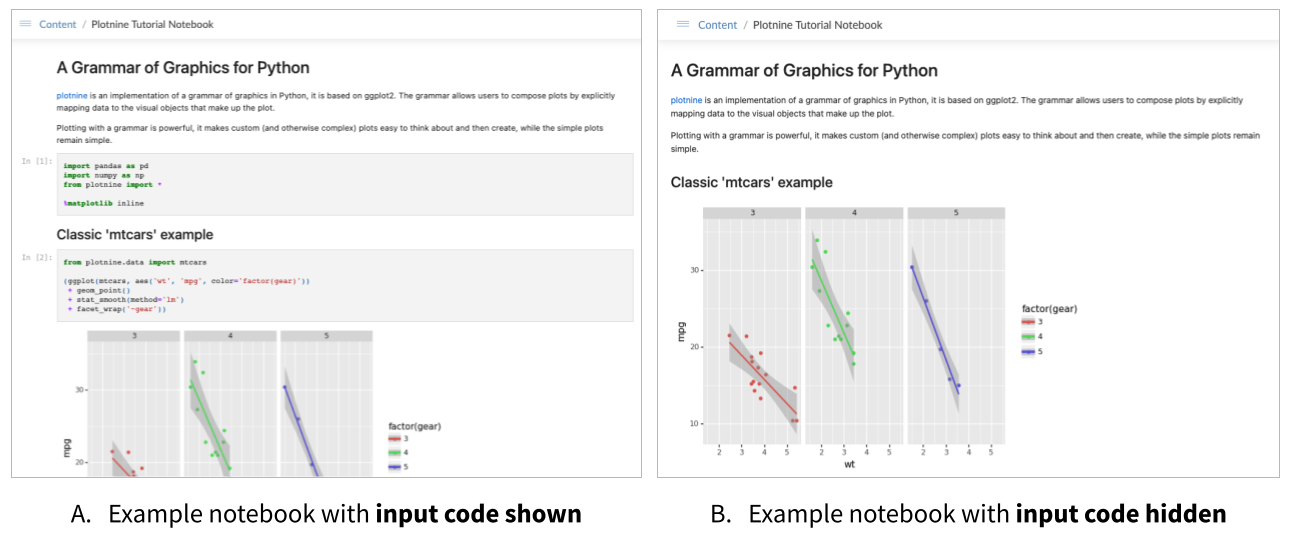

- #TUTORIAL PYTHON JUPYTER NOTEBOOK INSTALL#
- #TUTORIAL PYTHON JUPYTER NOTEBOOK FULL#
- #TUTORIAL PYTHON JUPYTER NOTEBOOK CODE#
Let’s test it out with a classic hello world example.
#TUTORIAL PYTHON JUPYTER NOTEBOOK CODE#
The first cell in the new notebook is always the code cell.

That is why you will select your python version to 3. I have selected mine which is in desktop/code/pyt folder. For this project, I am using Python 3. Creating Your First Notebookįirst, you need to select a project folder. Let’s launch it, and your terminal will be opened, and it will start a jupyter notebook on browser whose local URL is: Congratulations!! You have installed it successfully. Here, you can see the second option is a jupyter notebook, which we need to launch to work with Python.
#TUTORIAL PYTHON JUPYTER NOTEBOOK INSTALL#
The installation process is straightforward, and after you install the Anaconda, you will see the screen like below.
#TUTORIAL PYTHON JUPYTER NOTEBOOK FULL#
Since we started with Python 3, we can run Python code in our cells.Some of the biggest Python libraries included in Anaconda are NumPy, Pandas, and Matplotlib, though the full 1000+ list is exhaustive.Īnaconda lets us hit the ground running in your own fully stocked data science workshop without the hassle of managing the many installations or worrying about OS-specific dependencies. When we first create a new Jupyter Notebook, the first cell defaults to using code and the kernel we selected at the beginning. Insert: Insert cells above or below the selected cell View: Toggle headers, toolbars, and line numbers These options allow us to save our progress at different checkpoints and return back to them if we want to. “File” also gives us the options to “Save and Checkpoint” and “Revert to Checkpoint”. Note: We can use “File” to rename our notebooks. Let’s discuss what each of these menus does.įile: Create new notebooks or open existing notebooks In the above image, we can see a list of menus on our screen. Let’s select it and rename our notebook to “Jupyter Notebook Test”. At the top of the screen, we see “Untitled”. Live coding environments: Code can be changed and run in real-time with feedback provided directly in the browser Usability: JupyterHub allows you to share notebooks with large groups of users and Binder allows you to use Jupyter on GitHub in a browserĭocumentation: Great formatting options and inline output Interactive output: Code can produce rich output like HTML, LaTeX, images, and videosĬustomization: Ability to build custom components and customize JupyterLab to fit your workflow Sharing capabilities: Ability to share your notebooks with others using email, Dropbox, Github, or Jupyter Notebook Viewer Supported languages: Supports over 40 programming languages including Python, Scala, Julia, and R Let’s take a look at some of the reasons why Jupyter Notebook is so popular: It’s used at many top companies, such as Google, Microsoft, IBM, Bloomberg, NASA, and more. Jupyter Notebook has become the standard computational notebook for data management. It’s used for a variety of things, such as: Jupyter Notebook is a popular computational notebook, with over 2.5 million public notebooks available on GitHub. The hub allows you to deploy your notebooks to your organization, scale your deployment with Docker and Kubernetes, and provide uniform data management and access within your company. JupyterHub is a multi-user version of Jupyter Notebook, designed for teams, classrooms, and labs. JupyterHub is another offering from Project Jupyter. With JupyterLab, you can run terminals, text editors, and code consoles in your web browser. It allows you to set up your user interface to support various workflows in machine learning, data science, scientific computation, and more. In addition to the Jupyter Notebook, there’s also JupyterLab, which is a web-based IDE for Jupyter Notebooks. In 2014, Project Jupyter and Jupyter Notebook became spin-off projects from IPython and the IPython Notebook.

It’s maintained by the Project Jupyter community. Jupyter Notebook is an open-source web application used to create and share documents that have live code, equations, visualizations, and text.


 0 kommentar(er)
0 kommentar(er)
